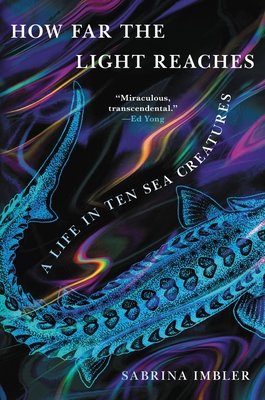Teeming with Life
By Zining Mok
Review of How Far the Light Reaches by Sabrina Imbler (USA: Little, Brown, 2022)
As I write, I am sitting in the comfort of Singapore, just days after returning home from Sabah, Malaysia, where my friends and I spent a full day snorkelling at the Tunku Abdul Rahman Marine Park. The waters seemed to me beautiful and clear, and yet much of the coral surrounding the islands was either dead or dying and, according to my friend who fishes, humming with the traffic of scavenger fish.
Amidst the grief and anxiety surrounding the climate crisis—with the World Meteorological Organization recently finding that we’re on track to breach the critical 1.5°C warming threshold in four years—Sabrina Imbler’s How Far the Light Reaches: A Life in Ten Sea Creatures is an oasis of wonderment. Among its inhabitants are the flamboyant cuttlefish, the purple octopus, and a hybrid butterfly fish. Together, the collection’s ten essays invite its readers to marvel at the multitudinous forms of life and ways of living that exist in the ocean, 90% of which is aphotic, its perpetual darkness unpenetrated by daylight, a world apart from the sunlit regions of earth in which humans live.
How Far the Light Reaches follows Dyke (geology) (Black Lawrence Press, 2020), a chapbook that blends science writing with autofiction. Likewise, each essay in the present collection braids science writing with memoir, and in so doing draws out a reflection on human ways of life. For example, the opening essay, “If You Flush a Goldfish,” details how dumped goldfish, which generally survive no more than a few years in a bowl, can live up to twenty years, grow to the size of cantaloupes, and thrive so much in the wild that they become an “ecological menace.” Imbler braids the reportage on goldfish with accounts of their childhood in a suburb of the Bay Area, when achieving the “right” kind of life—going to the right school, getting a good office job, having a heteronormative marriage—seemed like the pinnacle of success. Years later, when the speaker, now queer and out, returns for a visit, they find their ways of being no longer confined and governed by the myths of capitalistic success, gender expectations, and heteronormativity; much like a feral goldfish, they find themself changed in ways that would have been unimaginable to their past self.
The next nine essays follow a similar structure, but it is a structure that works and withstands repetition. Rhythmically, the braiding of science and memoir creates a leisurely tempo, allowing readers to sink into times and spaces apart from the regimented ones in which we live. As I read, I often found myself slowing down my reading pace, lingering in the world of each essay on quiet afternoons, wondering at the marvelous sea creatures. My personal favorite is the salps, free-floating and gelatinous tunicates more commonly known as sea squirts, which
exist in pulsating chains … made up of hundreds of identical salps joined hip to jiggly hip. Each clone is a distinct, barrel-shaped individual, yet all together the colony of clones makes up a single salp, attached and moving as one. … This is to say that individual identity is confusing for a salp, creatures for whom the notion of selfhood exists in the plural. For a salp, home is the rest of its salp.
A science journalist, Imbler writes about marine creatures in a style that is precise, accessible, and evocative, at times taking a lyric license that readers of creative nonfiction would appreciate. Structurally, each essay positions the speaker’s experiences in dialectical relation to the life of each sea creature. “We Swarm,” for instance, alternates between the salp and the speaker’s experience of going to the Dyke March and swarming, on the following day, to Riis Beach with their queer community. This formal separation allows thematic connections to surface as the essay unfolds, without domesticating the sea creatures into poorly fashioned, fishbowl-esque metaphors for human life.
Another one of my favorite essays from the collection, “My Grandmother and the Sturgeon,” draws particular affective power from the dialectical pitting of two threads against each other. The sea creature featured here is the Chinese sturgeon, whose spawning migrations from the ocean up the Yangtze River have been severely hampered by human activity, including dams and industrial pollution. Alongside reportage on the critically endangered sturgeon, Imbler recounts their grandmother’s own voyage up the Yangtze from Japanese-occupied Shanghai to Chongqing during the Second World War. It was a harrowing journey, one that was supposed to take less than a month but ended up taking six. At the end of the essay, after we learn about their grandmother’s failing memory, the speaker admits, “When I am sitting on the floor before the sturgeon tank at the New York Aquarium, I cannot help but think of her,” even if the sturgeon are from the Hudson rather than the Yangtze and have never known life beyond the tank. By pointing out this transference, Imbler beautifully captures the melancholic affect of being a child of migrants.
Within the parameters of the braided form, Imbler finds space for experimentation in two of the collection’s ten essays. “How to Draw a Sperm Whale” juxtaposes reportage on whale deaths with observations on the death of a relationship, and is written in the form of a necropsy report, which documents and interprets findings from the examination of a dead animal. More interesting is the final essay, “Us Everlasting,” which details how an immortal jellyfish that has sustained trauma “ages backwards,” first by “seal[ing] itself in an envelope of chitin and shuffl[ing] around the meaning of its cells,” then regenerating into a polyp that grows into jellyfish clones, in effect reliving its “childhood.” Finding that this mechanism resonates with the trope of a second adolescence in queer adulthood, Imbler invites fourteen contributors to imagine—What if you could do it all over again? What if you could have been yourself in childhood? The result is a community document of speculative adolescences.
As I came to the end of “Us Everlasting,” I found myself reminded of the opening essay, “If You Flush a Goldfish,” and marveling at how far we had come. Without my knowing, Imbler had brought me on a journey from a suburb where life is penned in by rigid, societal “shoulds” and into the deep sea, where creatures live fantastic, unimaginable lives. How Far the Light Reaches is, in this way, a sort of bildungsroman, but one that culminates in the gaining of enchantment and possibility rather than the loss of innocence. Indeed, as I read, I often found myself thinking, wow, life can look like this? This was, for me, profoundly liberating: all of a sudden, the societal expectations I had been struggling against for the past few years seemed so trivial.
Why be so attached to the ways of life we know as acceptable and desirable? This is the question that Imbler’s collection raises for me, and it is a question that is particularly pertinent now, with the literal foundations of certain ways of life being thrown into question by the climate crisis. Each year, the landfill on which Foster City (the setting of “If You Flush a Goldfish”) is built sinks by ten millimeters while the sea rises by three. Already, water splashes over the levees and onto doorsteps. Soon, Imbler writes,
the waves will overtake the levees and flood the farms, the city, the factories, the military bases, the tourist towns, the freeways, and the Petco. The water may doom the cats, caged birds, leopard geckos, bunnies, hamsters, and guinea pigs. But I like to imagine the fish slipping out of their tanks, heading toward some unknowable horizon.
Will we be doomed, or could we perhaps head, too, toward some unknowable horizon? Where will we go, and what will life look like? It’s a scary thought, but Imbler’s essay collection is saying, I think, that leaving one way of life for another is not as unimaginable as we think. Indeed, migrant communities and queer communities have been doing this for a long time. In the essay “Pure Life,” Imbler writes about the challenges of moving to Seattle alongside the incredible life of the yeti crab, which lives in hydrothermal vents, pockets of warmth and life in the deep ocean that are not only rare but also temporary. The deep ocean—and our planet’s future—may seem desolate. “But life,” writes Imbler, “always finds a place to begin anew, and communities in need will always find one another and invent new ways to glitter, together, in the dark.”
Zining Mok is obsessed with random things: orchids, arabesques, sand. Her first book The Orchid Folios (Ethos Books, 2020) was shortlisted for the 2022 Singapore Literature Prize in English Poetry. Her words can be found in Witness Magazine, the LARB, the Cincinnati Review, among other magazines. She lives in Singapore, where she is at work on an essay collection, The Earthmovers.
If you’ve enjoyed reading this article, please consider making a donation. Your donation goes towards paying our contributors and a modest stipend to our editors. Singapore Unbound is powered by volunteers, and we depend on individual supporters. To maintain our independence, we do not seek or accept direct funding from any government.










This Pride month, Ng Yi-Sheng reviews five queer comic titles bringing readers from the Philippines to Indonesia, Japan to Singapore, and to the USA.